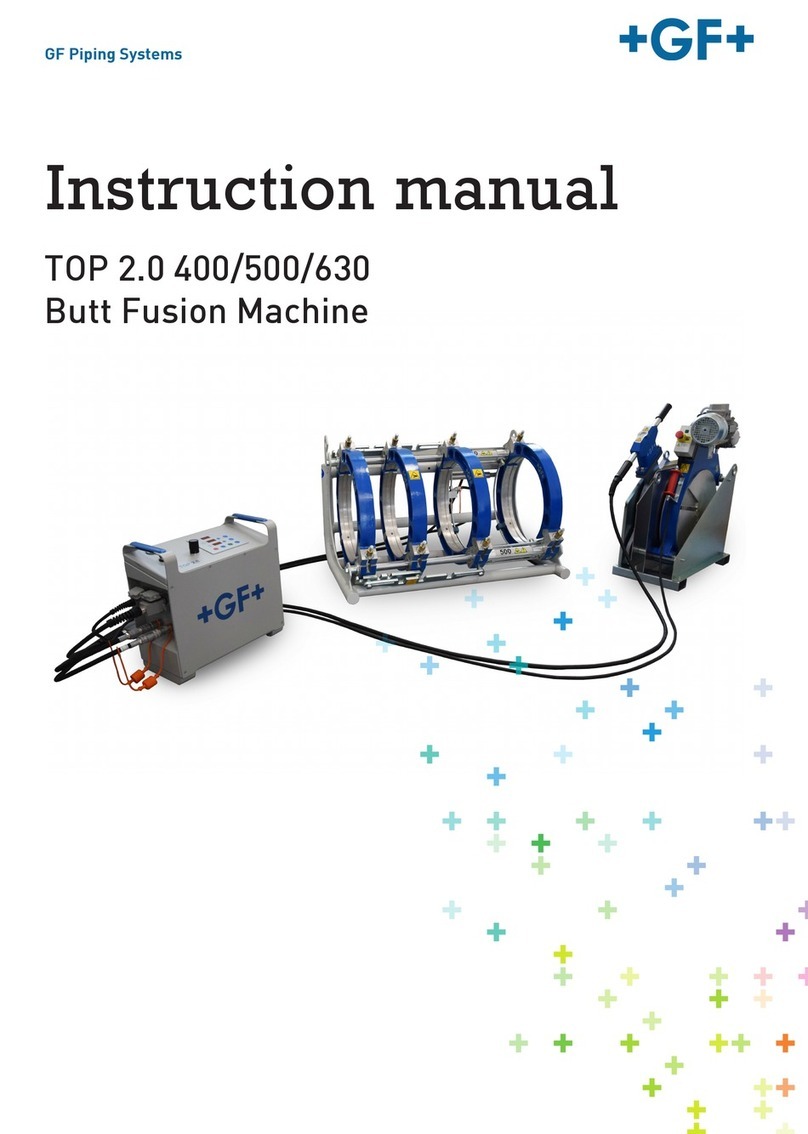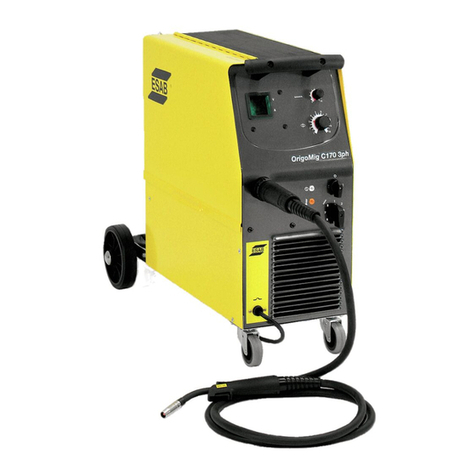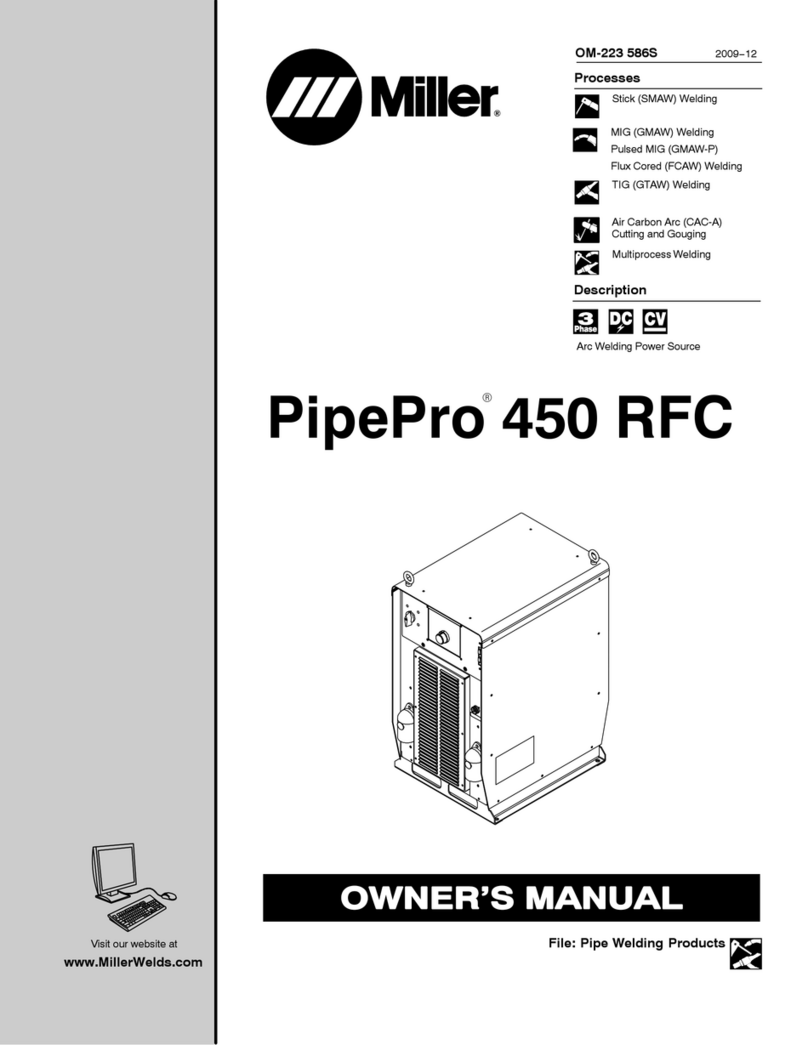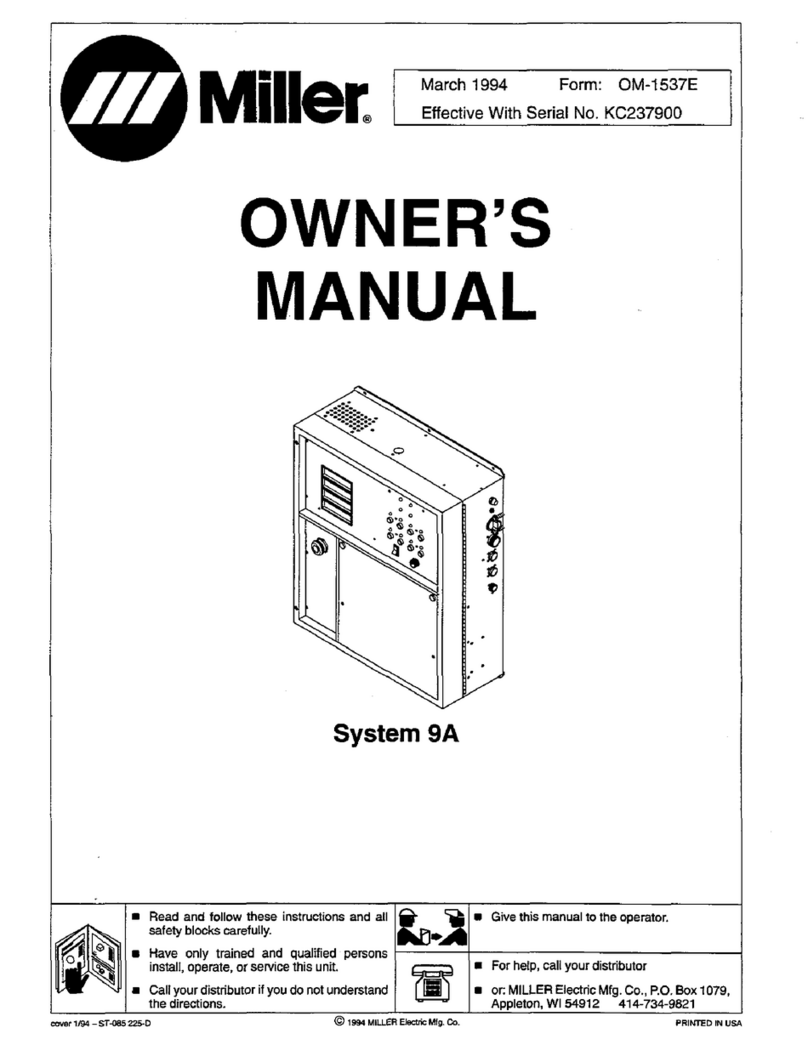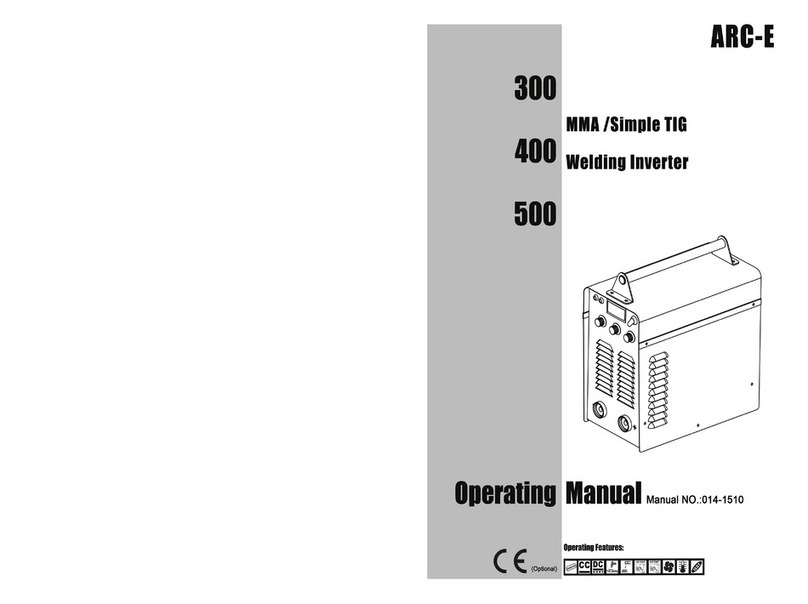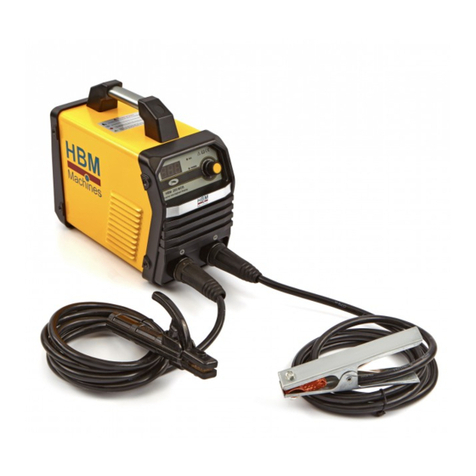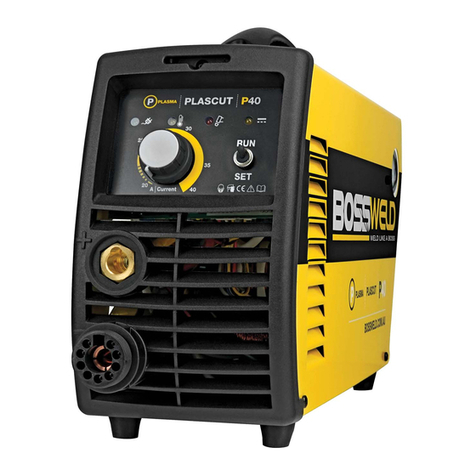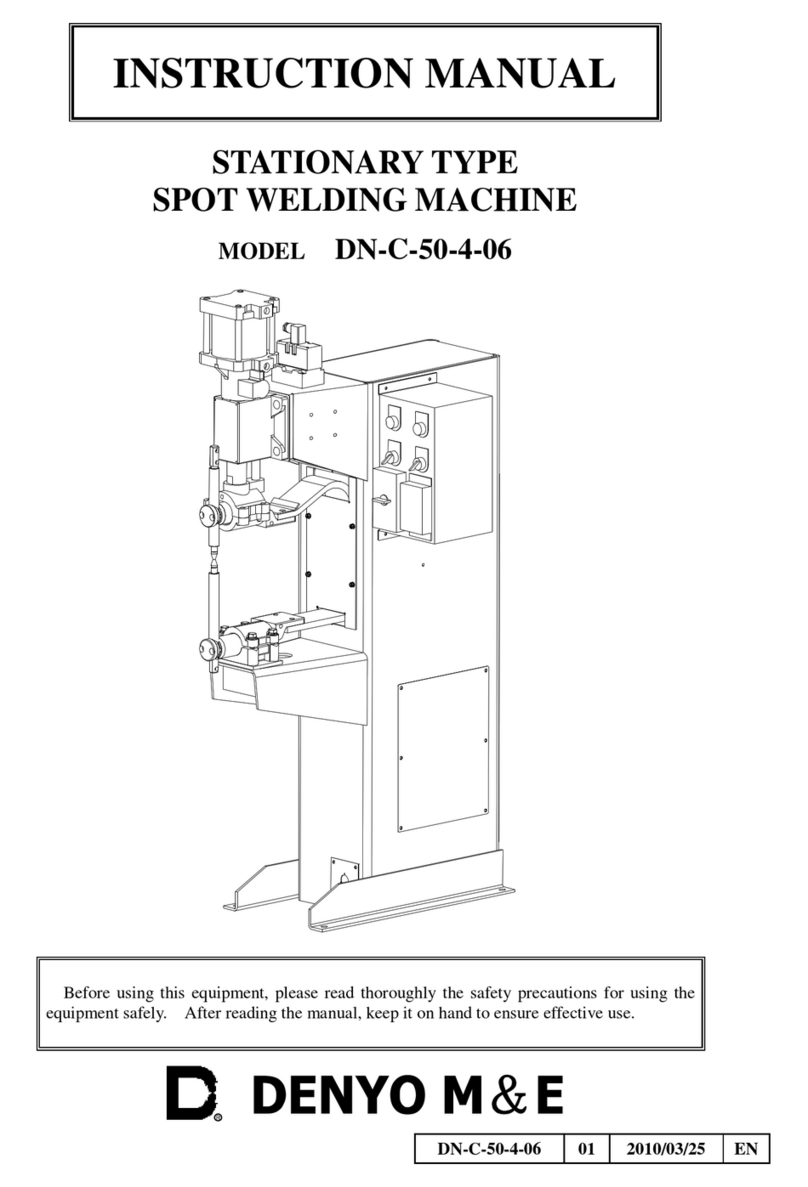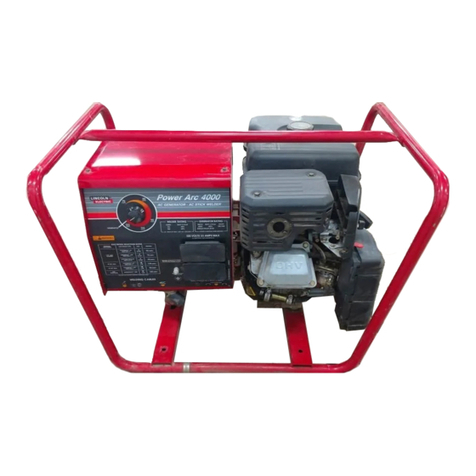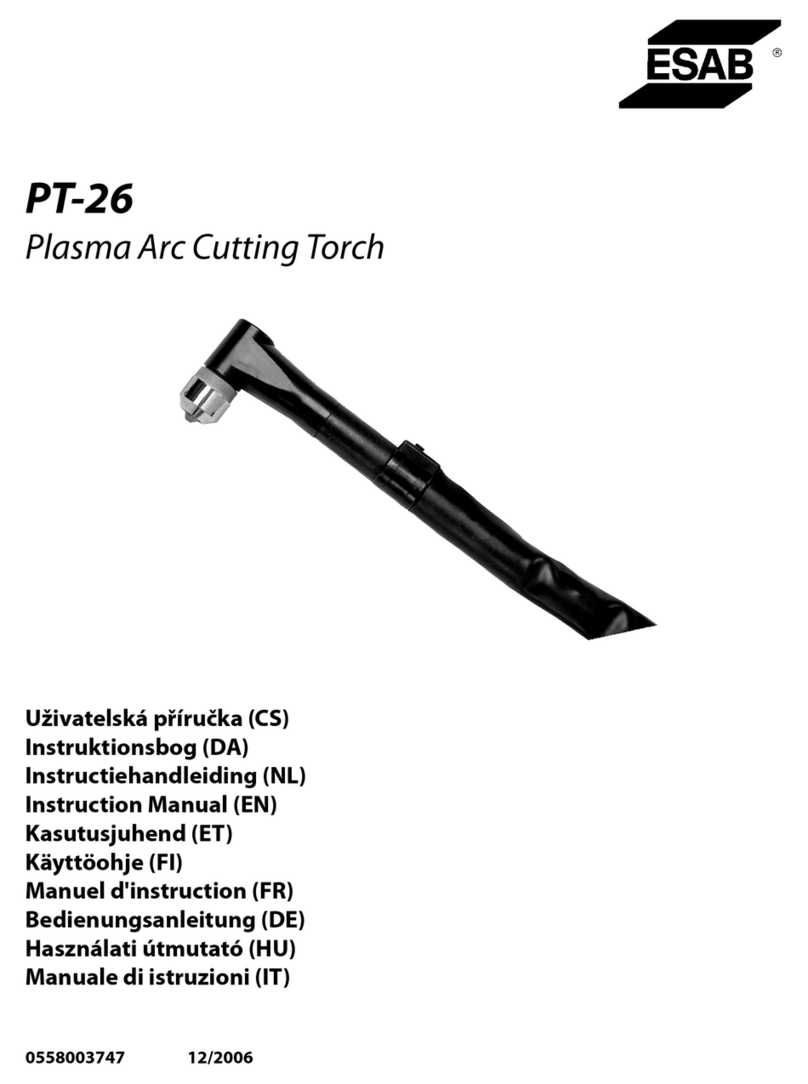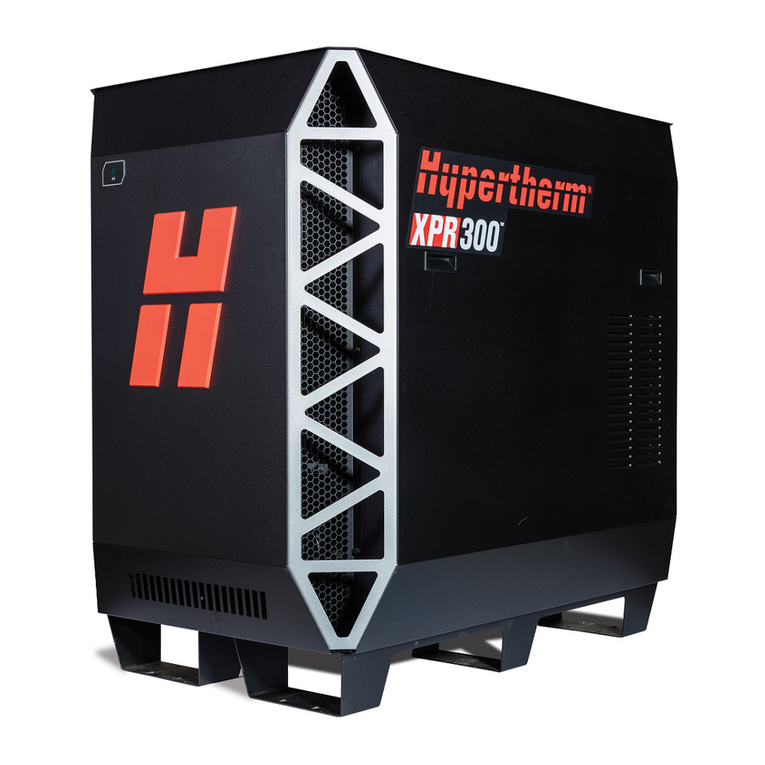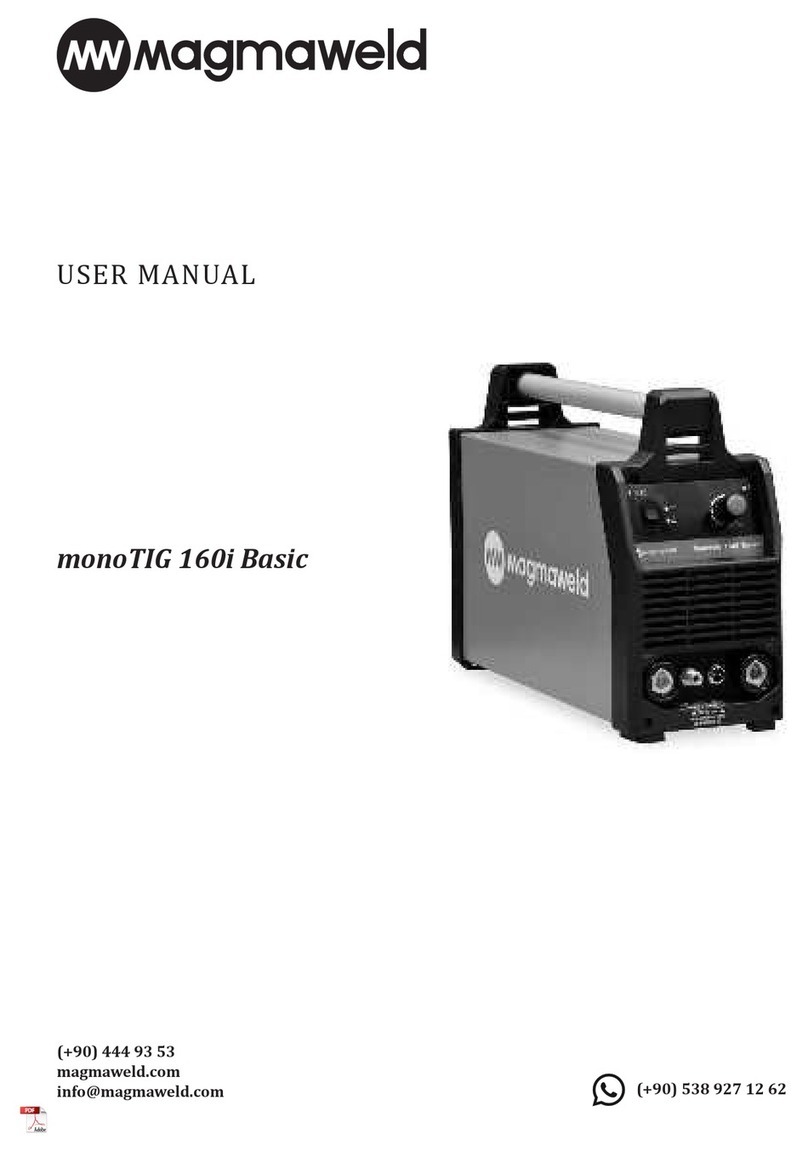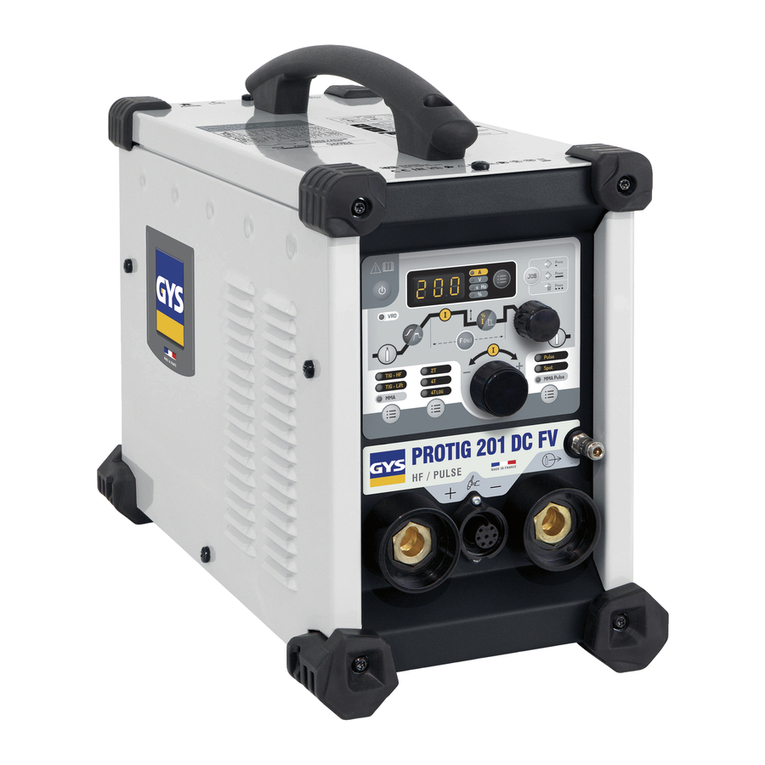GF Piping Systems ECOS 160 User manual

GF Piping Systems
Instruction manual
ECOS 160-315
Butt-Fusion Machine

All rights reserved,inparticular the rights ofduplication and distribution as wellas translation. Duplication and
reproductioninany form (print,photocopy,microfilm or electronic) requirethe writtenpermissionofGeorgFischer
Omicron S.r.l..

Operating instructions ECOS 160/250/315 Table of contents
I
Table of contents
Page
1
About this manual
1
1.1 Warning notice
1
1.2 Other symbols and notices
2
1.3 Abbreviations
2
2
Safety instructions
3
2.1 Proper use
3
2.2 General safety measures
3
2.3 Working with safety in mind
3
2.4 Disposal
5
3
General
6
3.1 Introduction
6
3.2 Range of application
6
3.3 Copyright
7
4
Product identification and description
8
4.1 Product identification
8
4.2 Product description
8
5
Technical specifications
10
6
Transport and assembly
11
6.1 Packaging
11
6.2 Sensitivity
11
6.3 Intermediate storage
11
6.4 Scope of delivery
11
7
Fusion preparation
12
7.1 General information
12
7.2 Preparations
12
7.3 Connection to mains
14
8
Fusion
15
8.1 The basics of butt fusion
15
8.2 The fusion process
16
8.2.1 Calculating drag pressure
16
8.2.2 Preparing the fusion surfaces
16
8.2.3 Calculating of the fusion pressure
18
8.2.4 Adjusting of the fusion pressure
18
8.2.5 Fusion process
19
8.3 Visual check of welding bead
21
8.4 Example ECOS 315/250
22
9
Failure analysis
23
10
Maintenance
25
10.1 Replacement ofworn parts
25
10.2 Hydraulic system
25
10.3 Hydraulic unit 25

Table of contents Operating instructions ECOS 160/250/315
II
11
Customer Service
28

Operating instructions ECOS 160/250/315 1 About this manual
1
1 About this manual
This manual is valid for ECOS 160, ECOS 250 and ECOS 315 butt-fusion machines
(hereinafter referred to as ECOS 160/250/315).
The warning notices, symbols and their meanings as used in this manual are explained
below to help you quickly understand the format of this instruction manual and how to
use the machine safely.
1.1 Warningnotice
Warning notices are used in this manual to inform you of possible injuries or damage
to property. Please read them and always abide by these warnings!
Symbol
Meaning
Danger
Imminent accute danger!
Failure to comply could result in death or extremely serious injury.
Warning
Possible accute danger!
Failure to comply could result in serious injury.
Caution
Dangerous situation!
Failure to comply could lead to injury or damage to property.

1 About this manual Operating instructions ECOS 160/250/315
2
1.2 Othersymbolsandnotices
Symbol
Meaning
Attention
Mandatory: you must observe this regulation
Advice
Suggest:This notice contains especially important information
1.3 Abbreviations
Abbr.
Meaning
ECOS 160
ECOS 250
ECOS 315
Butt fusion machine d 40–160 mm
Butt fusion machine d 75–250 mm
Butt fusion machine d 90–315 mm
DVS
Deutscher Verband für Schweisstechnik
(German Association of Fusion Technology)
PE
Polyethylene
PP
Polypropylene
PTFE
Polytetrafluorethylene
D
Pipe outer diameter

Operating instructions ECOS 160/250/315 2 Safety instructions
3
2 Safety instructions
The ECOS 160/250/315 Butt Fusion Machines are designed according to the latest
standards of technology. Using it for purposes other than those described in this
manual may cause injury to the operator or to others. It may also cause damage to the
machine or other equipment.
Any person in the company, who is involved in the assembly, disassembly,
reassembly, installation, operation or maintenance (inspection, maintenance work,
repair work) of the
ECOS 160/250/315, must have read and understood the complete instruction manual,
and in particular Section 1 on “Safety instructions”.
It is recommended that the user has this confirmed in writing.
Thus:
•The machine should only be used when in perfect working order.
•Always follow the safety instructions.
Complete documentation should be kept in the vicinity of the machine.
2.1 Proper use
The ECOS 160/250/315 are to be used exclusively for the fusion of pipes and fittings
made of PE, PP. Any other use is not permitted.
2.2 Generalsafetymeasures
•Use only the materials and dimensions specified in this manual. Other materials
may only be used after consulting Georg Fischer Omicron after-sales service.
•Use only original Georg Fischer Omicron spare parts and equipment.
•Inspect the ECOS 160/250/315 daily for visible signs of damageor defects. Have
damage or defects repaired immediately.
•Any work on the electricalequipment may only be done by a specialist.
•Observe all the regulations, standards and guidelines applicable in your country.
2.3 Workingwith safetyin mind
“Make your contribution to safety in the workplace."
•Report any deviations from normaloperation immediately to the person in charge.

2 Safety instructions Operating instructions ECOS 160/250/315
4
Always keep safety in mind while working.
For your own personal safety as well as for the safe and optimal handling of the
machine, the ECOS 160/250/315 must be installed correctly.
Connect hydraulic hoses to and from the machine only when the hydraulic unit is shut
off and not under pressure (observe manometer).
Danger of electric shock!
Inspect the electrical cords and devices!
Do not connect damaged cords or devices to the power supply.
Danger of burning!
The heater is hot (220 °C)!
Danger of burning hands on the hot heater.
Do not touch the heater when on.
Danger of burning!
Use the handles on the heater.
To move the heater, use the gloves! (EN 407 321XXX)
Danger of crushing hands!
The machine slide moves!
Danger of injury to hands in the moving machine slide!
Do not reach inside the machine when moving to the end positions.
Danger of cutting hands!
The planer blades are sharp!
Danger of cutting hands on the planer disk.
Do not touch the rotating planer disk.
Danger
Warning
EN 407 321XXX
Warning
Warning
Warning

Operating instructions ECOS 160/250/315 2 Safety instructions
5
Danger of injury due to high pressure oil leakages!
Inspect the outside wallof hydraulic hoses under pressure: make sure you wear safety
glasses before doing it!
Do not touch leaking oil with hands! Escaping high pressure oil can cause skin
penetration injuries!
Release the oil pressure to zero before replacing defective hoses.
Danger of bruising!
Machine components are heavy!
To move the components, use the gloves! (EN 388 2241)
2.4 Disposal
Shavings and used hydraulic oil should be disposed of properly.
Observe all the regulations, standards and guidelines applicable in your country.
Separate collection of electronic and electrical waste (from the equipment) has to be
ensured through appropriate systems.
note:
The here below symbol indicating separate collection for electrical and electronic
equipment according to 2002/96/CE WEEE directive (Waste Electrical and Electronic
Equipment).
EN 388 2241

3 General Operating instructions ECOS 160/250/315
6
3 General
3.1 Introduction
This instruction manualwas written for those persons responsible for the operation and
care of the ECOS 160/250/31. It is expected and assumed that such persons have read,
understood and will abide by the manualin its entirety.
Only with the knowledge contained in this manualcan faults on the ECOS
160/250/315 be prevented and trouble-free operation be ensured. It is therefore
imperative that the responsible persons are familiar with this manual.
We recommend that this manualbe read carefully prior to putting the machine in
operation, as we are not liable for any damage or interruptions in operation resulting
from failure to comply with this manual.
Should problems nevertheless arise, please contactdirectly Georg Fischer Omicron
s.r.l. or the nearest servicerepresentative.
This manual applies only to the ECOS 160, ECOS 250 and ECOS 315 butt-fusion
machines (hereinafter referred toas ECOS 160/250/315).
We reserve the right to make the technicalchanges necessary to improve the ECOS
160/250/315 which may result in deviations from the illustrations and information
contained in thismanual.
3.2 Range ofapplication
The ECOS 160/250/315 is designed exclusively for the fusion of thermoplastic plastic
pipes, fittings and valves according to the specified dimension range. Any other use is
not authorized. The manufacturer cannot be held liable for damages resulting from
unauthorized use; the user bears sole responsibility.

Operating instructions ECOS 160/250/315 3 General
7
3.3 Copyright
The copyright for this instruction manualis held by Georg Fischer Omicron S.r.l..
This instruction manual is intended for assembly, operation and maintenance
personnel. No part of the technical regulations or illustrations contained herein may be
reproduced or distributed in any form, used illicitly for competitive purposes or passed
on to others.
GeorgFischerOmicron S.r.l
Via E. Fermi, 12
I 35030 Caselle di Selvazzano
Padova (Italy)
Telephone +39 049 8971411
Fax +39 049 8971410

4 Product identification and description Operating instructions ECOS 160/250/315
8
4 Product identification and
description
4.1 Productidentification
According the directives for machines an identification tag is added to the base
machine, showing the following information:
1. Manufacturer
2. Type of machine
3. Serial number
4. Piston area
5. Pipes range
6. Year of manufacture
7. Wheight
8. Barcode
4.2 Productdescription
Base Machine
•Hardened and hard chrome-
plated guide
shafts (1)
•Third clamp is adjustable (2)
•Pull-
Off mechanism for heating element
(3)
Hydraulic unit
•Precision manometer Class 1, scale 0–
160 bar (0-
100 bar TM 160), diameter
100 mm (1)
•Lightweight compact hydraulic unit IP-
33, steel protection frame, control lever
(2)
•
Freely adjustable pressure regulator,
equalization and fusion pressure can be
pre-set (3)
•Integrated flexible hoses. Anti-
drip,
rapid-action coupling with prot
ective
caps .
1
2
3
3
2
1
2
3
4
8
5
6
1
7

Operating instructions ECOS 160/250/315 4 Product identification and description
9
Heatingelement
•PTFE-coating
•Power multi-cord (4 m)
•Integrated electronic
temperature
controller (1)
•Integrated thermometer (2)
Electric planer
•Torque transmission via robust worm-
gear device
•Self locking device against accident
al
unhooking (1)
•Planer blades sharpened on both sides (2)
•
Safety micro switch against accidental
starting (3)
Storage Case
•Zinc-
coated steel case for transport and
storage of both heating element and pipe
planer
2
1
3
1
2

5 Technical specifications Operating instructions ECOS 160/250/315
10
5 Technical specifications
Machine
description
Butt-fusion machine to weld thermoplastic pipes PE,
PP
Type
ECOS 160
ECOS 250
ECOS 315
Serial No.
............
............
............
Total piston
area
353 mm2
510 mm2
510 mm2
Max. pressure
100 bar
160 bar
160 bar
Type of
hydraulic oil
LI 46 SHELL
(viscosità 46)
LI 46 SHELL
(viscosità 46)
LI 46 SHELL
(viscosità 46)
Quantity of
hydraulic oil
2,0 l
2,0 l
2,0 l
Noise level
70 dB(A)
70 dB(A)
70 dB(A)
Tension
230 V / 50 Hz
230 V / 50 Hz
230 V / 50 Hz
Performance
1900 W
3070 W
3670 W
Dimension
(packaging)
105x68x68 cm
158x83x84 cm
158x83x84 cm

Operating instructions ECOS 160/250/315 6 Transport and assembly
11
6 Transport and assembly
6.1 Packaging
A decisive factor in the choice of packaging is the means of transport. Usually the
machine and all the accessories are delivered in a cardboard box on a pallet or wooden
case upon request.
6.2 Sensitivity
Special care must be taken when transporting the machine in order to prevent damage
from impact or improper loading and unloading.
All movable parts must be fixed in place.
Transport insurance should be provided for according to the type and duration of
transport. Condensation due to large temperature fluctuations and sharp jolts during
shipment should be avoided.
Please handle the machine with care.
6.3 Intermediate storage
If the machine is not used immediately upon delivery, the machine must be stored in a
safe place and properly covered.
6.4 Scopeofdelivery
The contents (number of transport crates, pallets, packages) and their condition should
be checked immediately upon receipt. Any damage and/or missing parts should be
noted right away on the bill of lading and reported to Georg Fischer Omicron S.r.l.
without delay.

7 Fusion preparation Operating instructions ECOS 160/250/315
12
7 Fusion preparation
7.1 Generalinformation
The Fusion Process described in the following chapters is based on the instruction
sheets and guidelines issued by the DVS 2207.
The fusion area should be protected against the influences of weather (humidity,
ambient temperature <+ 5 °C, extreme direct exposure to sun) with such measures as
pre-warming the fusion materials, tents, heating.
For optimal use of the ECOS 160/250/315 the operating personnel should be specially
trained by Georg Fischer. In-depth knowledge of the machine and it´s components and
competence rule out handling errors thereby also preventing faulty fusion joints.
7.2 Preparations
The standard configuration of the base machine is prepared to joint pipe to pipe by
using 2 clamps to fix each pipe in the base machine. The planer and the heating
element is inserted between the two central clamps.
In order to clamp particular constructions or T-pieces or to use a flange adapter, shift
the clamping unit B to the required position. Therefore remove the two spacers C
(upper and lower on) from the original position, position the clamping unit B and fix it
with the two spacers C. The pipe preparation and welding position is now changed,
insert the heating element into the pull-off mechanism between A and B.
Clean the couplings on the base machine and the hoses.
Connect the hydraulic hoses to the base machine and to the hydraulic unit.
If the hydraulic hoses are not used, seal the couplings with the protective caps. Clean
the protective caps first.
Replace the heater if the PTFE -coating is damaged. Failure to comply could impair the
quality of the fusion weld.
In order to weld pipes and/or fittings with an outer diameter smaller than the clamp of
the base machine, insert matching clamping half shells and fasten them with the
screws.
Advice

Operating instructions ECOS 160/250/315 7 Fusion preparation
13
Clamp the components to be jointed in that way, that the pipe/fitting ends reach out at
least 30 mm from the clamps (ECOS 250 – 315) in order to perform a proper weld.
Make sure they are exactly aligned in the axial direction.
ECOS 160 is equipped witha stroke indicator. When pipes are
positioned into thebasemachine, closethecarriages till thepipes
arein contactwith themselves. Control the position of the stroke
indicator in relationto the red mark (cylinder stroke end). If the
indicator is close to the red mark, duringthe weldingprocedure no
pressure could be transferred into thewelding zone!The weldwill not
perform!!Change the clamping positionof the pipes!After planning
the pipe ends, the distance between the indicator and the mark hasto
grantthe movementduring bead build up, heat soak phase and bead
roll over!
If necessary, the components can be turned or the clamping force changed to achieve a
better clamping position.
Adjustable roller supports or a floating suspension assist horizontal movement of the
pipes fixed in the carriage.
Attention
Stroke indicator
Stroke end mark

7 Fusion preparation Operating instructions ECOS 160/250/315
14
7.3 Connectionto mains
Danger of electric shock!
Inspect the electrical cords and devices!
Do not connect damaged cords or devices to the power supply.
1. Connect the hydraulic unit, the heating element and the planer to the power outlet
or power generator.
Check the voltage!
The generator has to be started before connecting the consumer and
must supply a constant output tension! Any sudden changes could
compromise the correct welding result and/or damage the control.
2. Set the correct fusion temperature on the heating element with the temperature
controldial.
•Functions of control lights:
Red and green lights are on during heating up.
When the fusion temperature is reached, the red light blinks.
3. Check the temperature of the heater plate surface with a quick-indication
temperature measurement according to the set temperature.
Before beginning with the first fusion,we recommendwaiting approx. 10
minutes afterthe setfusion temperature hasbeenreached, toallow even
heat distribution.
Danger
Caution
Advice

Operating instructions ECOS 160/250/315 8 Fusion
15
8 Fusion
8.1 Thebasicsofbutt fusion
For butt fusion with a heating element, the parts to be joined (pipe/pipe, pipe/fitting or
fitting/fitting) are heated to fusion temperature in the fusion area and are fused under
pressure without the use of additional materials.
The heating element butt fusion joint must be done with a controllable equalization
pressure.
Only the same type of materials are to fuse.
The wall thicknesses in the fusion area need to be the same.
Correct
Incorrect
Only the same wall thicknesses in the fusion area!
The equalization pressure (phase 1) and the fusion pressure (phase 5) are identical. The
heat soak pressure (phase 2) is significant lower, but the contact between the
pipe/fitting and the heating element needs to be ensured.
Attention
1
2
3
4
5

8 Fusion Operating instructions ECOS 160/250/315
16
8.2 Thefusionprocess
8.2.1 Calculating drag pressure
Danger of injury due to high pressure oil leakages!
Inspect the outside wallof hydraulic hoses under pressure: make sure you wear safety
glasses before doing it!
Do not touch leaking oil with hands! Escaping high pressure oil can cause skin
penetration injuries!
Release the oil pressure to zero before replacing defective hoses.
Danger of crushing hands!
The machine slide moves!
Danger of injury to hands in the moving machine slide!
Do not reach inside the machine when moving to the end positions.
The machine drag pressure mustbe calculatedbefore each new fusion!
1. Open the machine to the end position by moving the control lever (2) into open
direction “<>”.
2. Reduce pressure with the fine-adjustment pressure valve (3) -turn counter-
clockwise.
3. Increase pressure with the fine-adjustment pressure valve while simultaneously
pulling the control lever in the “close ><” direction (turn clockwise).
4. As soon as the movement of the carriage is even, stop increasing the pressure and
read the pressure value on the gauge before the pipe ends are in contact.
8.2.2 Preparing the fusion surfaces
Danger of cutting hands!
Sharp planer blades!
Danger of injury to hands if the planer disk is touched.
Do not touch the rotating planer disk.
Snap in the safety lock.
1. Open the machine to the end position by moving the control lever into open
direction “<>”. Check that the distance between the pipe ends is at least as wide as
the width of the planer.
2. Insert the planer to the base machine with care .Safety mechanism locks
automatically. This prevents the planer unit from jumping out of the machine
during planing.
3. Check that the signal lamp is ON, this indicates that the planer is inserted correctly.
Warning
Warning
Warning
1
2
3
This manual suits for next models
2
Table of contents
Languages:
Other GF Piping Systems Welding System manuals

